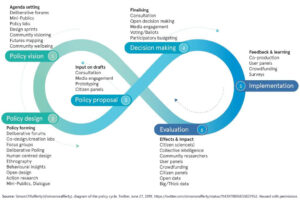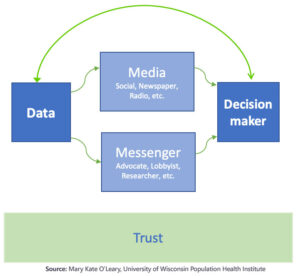Defining Policy
What is policy: Policy is defined as rules, regulations, priorities, protocols, processes, or practices that occur within or across governmental, institutional, and organizational levels. These are most often thought of as formalized, but can also be informally agreed upon, or even implicit understandings of “how we do things.”
Why does it matter: Policies have a tremendous impact on health and health equity, even when they do not appear to directly deal with health or healthcare. Policies can have ripple effects – positive and negative – in communities for generations and are important levers for change to address health and health inequities. Inequities in the policy making process continue not only through initial policy decisions themselves, but also through their legacy on resources (i.e., money, knowledge, or influence) that influence long-term power imbalances. For more information about health equity and policy, see Building Health Equity Policy Agendas: A Guide for Wisconsin.
Below are a number of questions to consider when working with decision makers.
Stage in the Policy Process
The model below visualizes the policy making process and its steps and highlights how people can engage at these different steps. Data can be introduced at any of these various steps by messengers. The steps in the policy process and the messengers introducing data can influence if and how data are used.

The Current Policy Agenda
A policy agenda is the slate of issues that are under consideration by a governing body or decision maker. Agenda setting is a process through which the governing body narrows the range of issues on its agenda and is part of the policy vision step in the policy process. What is on the policy agenda will shape what data is relevant. In addition, data can be used to inform the agenda setting process.
The Relevant Policy Lever
 Policies, while often thought of as legislative, can also include a wide variety of levers for change that takes many shapes and forms, with several examples below. These levers are often identified in the policy design step of the policy process. Different types of data can be used to monitor the effectiveness of various levers for change. Data can also help identify which levers might be most effective at influencing equitable health outcomes.
Policies, while often thought of as legislative, can also include a wide variety of levers for change that takes many shapes and forms, with several examples below. These levers are often identified in the policy design step of the policy process. Different types of data can be used to monitor the effectiveness of various levers for change. Data can also help identify which levers might be most effective at influencing equitable health outcomes.
Here is a list of levers that can impact health:
- Legislative policy, statute, or ordinance: Legislation, such as state statutes and city ordinances, that regulate how things are done
- Plans: Detailed proposals approved by a governing body or decision maker for doing or achieving something
- Procedures: Required steps to be taken to accomplish a task like data sharing
- Organizational policy: Rules and regulations employees must follow to keep business running smoothly
Who is the Decision Maker
The decision making step in the policy process involves key individuals, or decision makers. They have the power to make policy and policy changes. Knowing who ultimately makes the decision and the decision making process can inform how data should be framed and presented and to whom. It might also be important to consider who influences decision-maker(s) and where there are opportunities for input.
Here are some examples of policy change targets and associated decision makers:
- Organizational Change: determining what data to share with other referring organizations; changing protocols, practices within and across organizations, including items like screening practices, changing protocols for data sharing, etc.
- Decision makers include CEOs, executive directors, and boards
- County Government: They have jurisdiction in non-city parts of the county (towns). County governments often have contracts for various types of work (roads, mental health, etc.) and can include different requirements in contracts
- Decision makers include County Boards and Committees
How a Decision Maker Becomes Aware of Data

There are many different pathways in which a decision maker becomes aware of data. Many pathways of data sharing include a person who delivers the message to the decision maker, known as the messenger. Examples of messengers include academic researchers, community constituents, advocates, committees, and colleagues. An additional pathway could be the media (e.g., a letter to the editor or op-ed, radio or television interview, editorial board, or organizational newsletter or issue brief). Other times decision makers or their staff directly seek out data from sources. All these pathways are key to the transfer of data to decision makers.
Trust is a key factor in the transmission of information and data sharing. Trust impacts whether a decision maker pays attention to the information. Trusted sources, meaning the place where the data was retrieved from, matter to decision makers. The trust of the messenger is also a key component to data exchange.
How to Present Data to a Decision Maker
Impact
 In your message, it is important to immediately grab the attention of your decision maker. This can be done by using data or by sharing an impactful story. It is important to then restate the problem and the solution you are proposing. Lastly, a call to action will help the decision maker understand what you are asking of them.
In your message, it is important to immediately grab the attention of your decision maker. This can be done by using data or by sharing an impactful story. It is important to then restate the problem and the solution you are proposing. Lastly, a call to action will help the decision maker understand what you are asking of them.
Framing
A frame is a central organizing idea for making sense of a relevant issue and explaining why it matters. When crafting your message to decision makers, it is important to understand who you are going to be talking to and their level of influence. Providing additional narrative to support data helps to reinforce the message to decision makers. If possible, provide examples of policies relevant to the data that is being shared.
Presentation
The way data is presented is crucial. You will need to consider how you are presenting the data and in what format— a hard copy of a report, presentation, email, etc. The presentation of data should be visually appealing, understandable and concise.
Getting Decision Makers to Take Action
Decision makers need to understand what you want them to do with the data you are sharing with them. What you want them to do may depend on the step in the policy process. In advance, it is crucial you prepare:
- The takeaway message
- What you want policymakers to do as a result of you sharing your data with them
- The policy-related action you want them to take
Other Resources on Policy
- 30 Tips for Good Advocacy
- A Citizen's Guide to Participation in the Wisconsin State Legislature
- Hosting a Successful In-District Meeting
- Building Health Equity Policy Agendas: A Guide for Wisconsin
Please note the difference between educational advocacy and lobbying here.
Examples of Using Reports for Policy
To see examples of how reports can be used for policy, view the Examples page.

